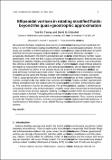Ellipsoidal vortices in rotating stratified fluids : beyond the quasi-geostrophic approximation
Abstract
We examine the basic properties and stability of isolated vortices having uniform potential vorticity (PV) in a non-hydrostatic rotating stratified fluid, under the Boussinesq approximation. For simplicity, we consider a uniform background rotation and a linear basic-state stratification for which both the Coriolis and buoyancy frequencies, f and N, are constant. Moreover, we take ƒ/N≪1, as typically observed in the Earth’s atmosphere and oceans. In the small Rossby number ‘quasi-geostrophic’ (QG) limit, when the flow is weak compared to the background rotation, there exist exact solutions for steadily rotating ellipsoidal volumes of uniform PV in an unbounded flow (Zhmur & Shchepetkin, Izv. Akad. Nauk SSSR Atmos. Ocean. Phys., vol. 27, 1991, pp. 492–503; Meacham, Dyn. Atmos. Oceans, vol. 16, 1992, pp. 189–223). Furthermore, a wide range of these solutions are stable as long as the horizontal and vertical aspect ratios λ and μ do not depart greatly from unity (Dritschel et al.,J. Fluid Mech., vol. 536, 2005, pp. 401–421). In the present study, we examine the behaviour of ellipsoidal vortices at Rossby numbers up to near unity in magnitude. We find that there is a monotonic increase in stability as one varies the Rossby number from nearly −1 (anticyclone) to nearly +1 (cyclone). That is, QG vortices are more stable than anticyclones at finite negative Rossby number, and generally less stable than cyclones at finite positive Rossby number. Ageostrophic effects strengthen both the rotation and the stratification within a cyclone, enhancing its stability. The converse is true for an anticyclone. For all Rossby numbers, stability is reinforced by increasing λ towards unity or decreasing μ. An unstable vortex often restabilises by developing a near-circular cross-section, typically resulting in a roughly ellipsoidal vortex, but occasionally a binary system is formed. Throughout the nonlinear evolution of a vortex, the emission of inertia–gravity waves (IGWs) is negligible across the entire parameter space investigated. Thus, vortices at small to moderate Rossby numbers, and any associated instabilities, are (ageostrophically) balanced. A manifestation of this balance is that, at finite Rossby number, an anticyclone rotates faster than a cyclone.
Citation
Tsang , Y-K & Dritschel , D G 2015 , ' Ellipsoidal vortices in rotating stratified fluids : beyond the quasi-geostrophic approximation ' , Journal of Fluid Mechanics , vol. 762 , pp. 196-231 . https://doi.org/10.1017/jfm.2014.630
Publication
Journal of Fluid Mechanics
Status
Peer reviewed
ISSN
0022-1120Type
Journal article
Description
Support for this research has come from the UK Engineering and Physical Sciences Research Council (grant number EP/H001794/1).Collections
Items in the St Andrews Research Repository are protected by copyright, with all rights reserved, unless otherwise indicated.

